Mount Union’s 2019 SCHOLAR Day Highlights
May 02, 2019"How Study Abroad Influences Perception of Diversity on Campus"
Dr. Sarah Torok-Gerard
Ashley Griffin - Human Development and Family Science – Clinton, OH
Judith Karlen – Psychology – Canton, OH
Megan Haynam – Psychology – Minerva, OH
Taylor McMorrow - Human Development and Family Science and French – Avon, OH
Elizabeth Jones - Human Development and Family Science and French – Medina, OH
With the rise in popularity of study abroad programs, a team of five juniors and seniors in the Department of Psychology, Neuroscience, and Human Development undertook a study entitled, “How Study Abroad Influences Perception of Diversity on Campus.” Under the guidance of Sarah Torok-Gerard associate professor of psychology the group presented their findings using data collected from Mount Union’s student population. McMorrow and Jones double majored in French and Spanish, respectively, and had studied abroad themselves.
The study examined whether the experience of studying abroad impacts students’ openness to diversity on their home campus and whether negative study abroad experiences and positive study abroad experiences resulted in different perceptions. Using surveys, the researchers collected data from 69 third and fourth-year students who had and had not studied abroad across academic disciplines and length of program study. Their findings concluded three things. First, students who have studied abroad did not perceive campus differently and as less diverse than those who did not study abroad. Second, students who studied abroad were more open to diversity than those who did not study abroad. Third, whether students had a positive or negative study abroad experience did not impact their overall perceptions of diversity. The researchers pointed out the limitations of their study but hoped that the data and research could be utilized by the University’s Center for Global Education.
“Student Travel Analyzed Through the Lens of Enterprise Risk Management”
Professor Holly Lucas
Lucy Baer – Finance and French – Leetonia, OH
Ethan Kawecki – Finance and Economics – Salem, OH
Margaret O’Donnell – Finance and Marketing – Avon, OH
Mallory Wahl – Finance and Accounting – Shreve, OH
The presentation researched and analyzed the current Mount Union student travel policy against an Enterprise Risk Management. The group defined what Enterprise Risk Management is and how it affects both small and large universities. The presentation looked at individual points inside the current policy and indicated where the highest risk and likelihood of something happening might exist. The students came up with suggestions on how the University could look to implement procedures they believe would lower the risk.
“Mount Union has put in quite a bit of extra time and work developing heat maps and creating these loss exposures and really the whole primary purpose of them doing so is to ensure the safety of the campus community as a whole,” said Baer.
One of the recommendations were “trauma kits” in each campus vehicle. “Imagine you’re in the vans and they break down or there is a minor or major car accident. Right now, the vans are not prepared for that. There aren’t jumper cables, band aids or anything for major trauma. We recommend putting a trauma kit in the back…putting jumper cables, maybe a spare tire and a first aid kit for major or minor injuries,” O’Donnell said.
“We were able to take some of the recommendations and implement them into our current policies. It’s something we’re still looking at, but we are definitely looking at the feedback,” said Shawn Bagley, Purchasing and Risk Manager for University of Mount Union.
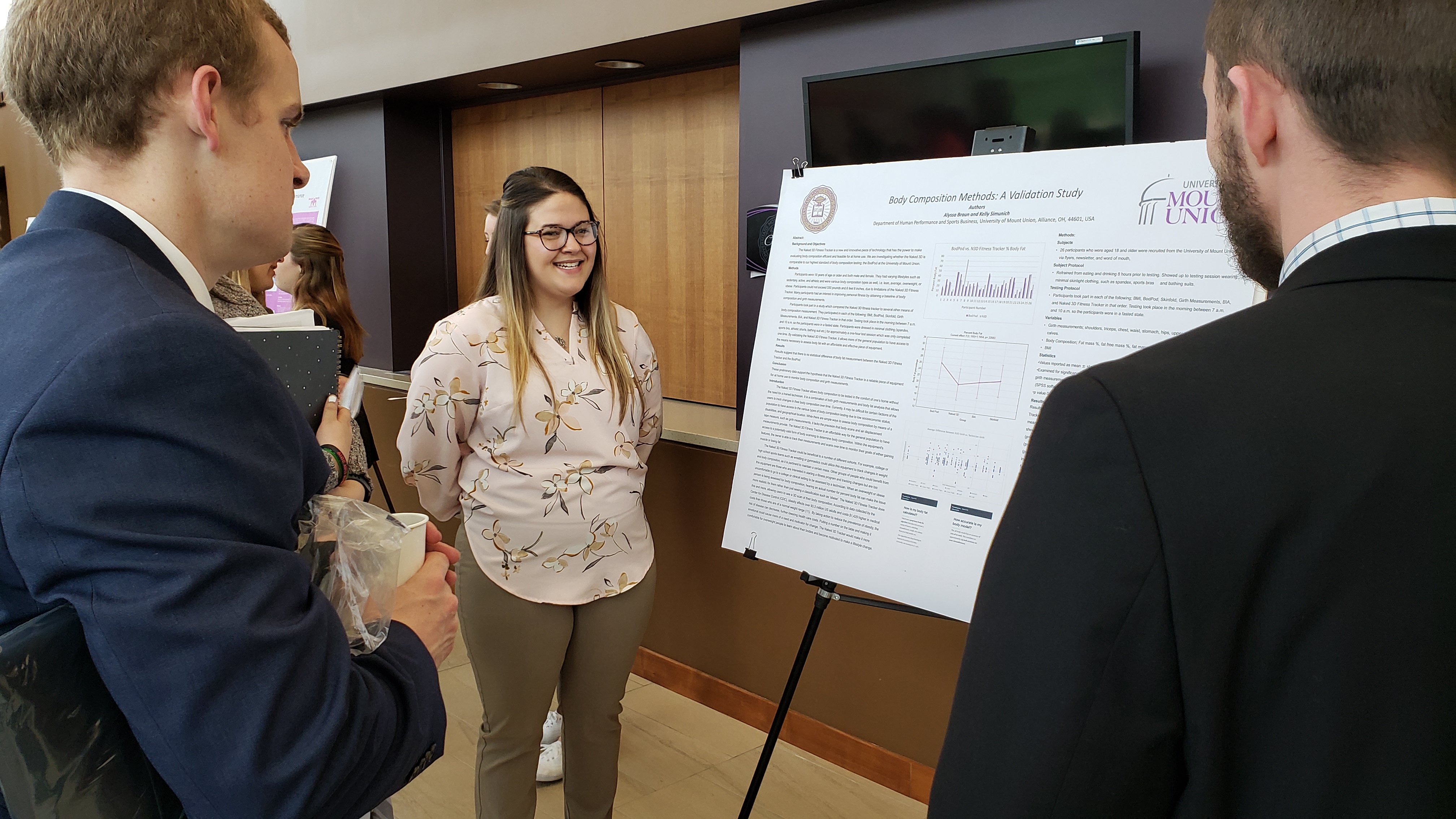
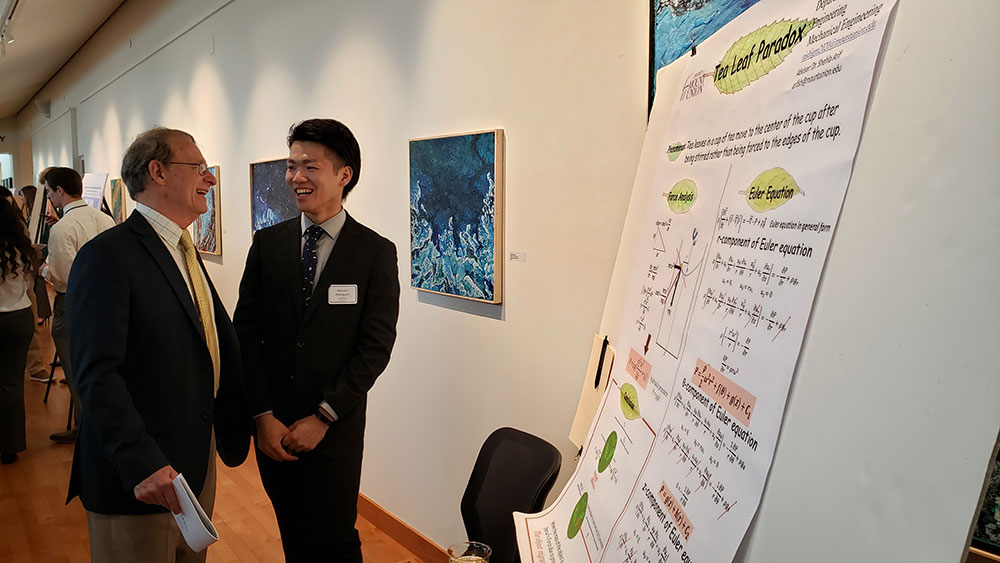

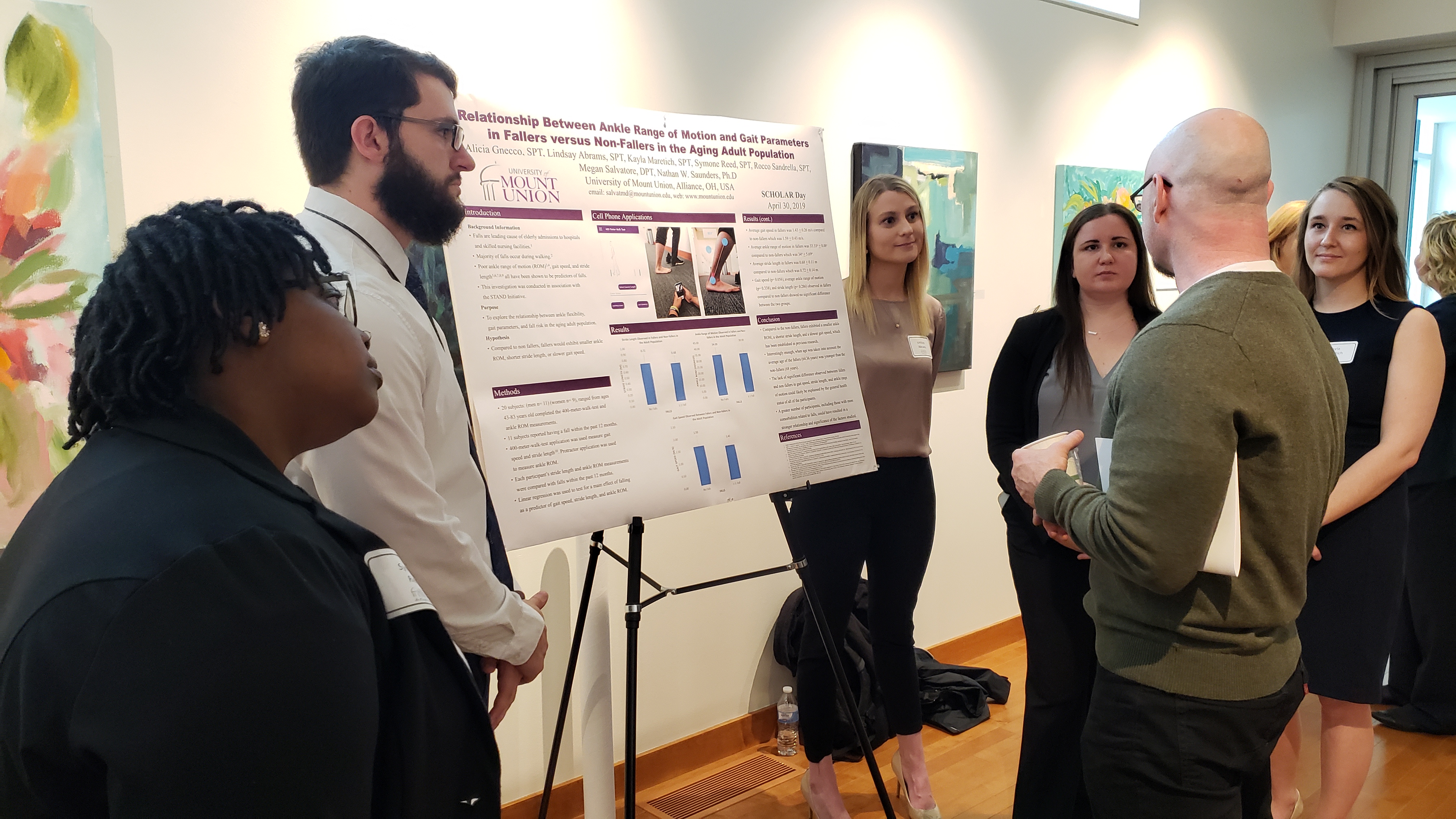
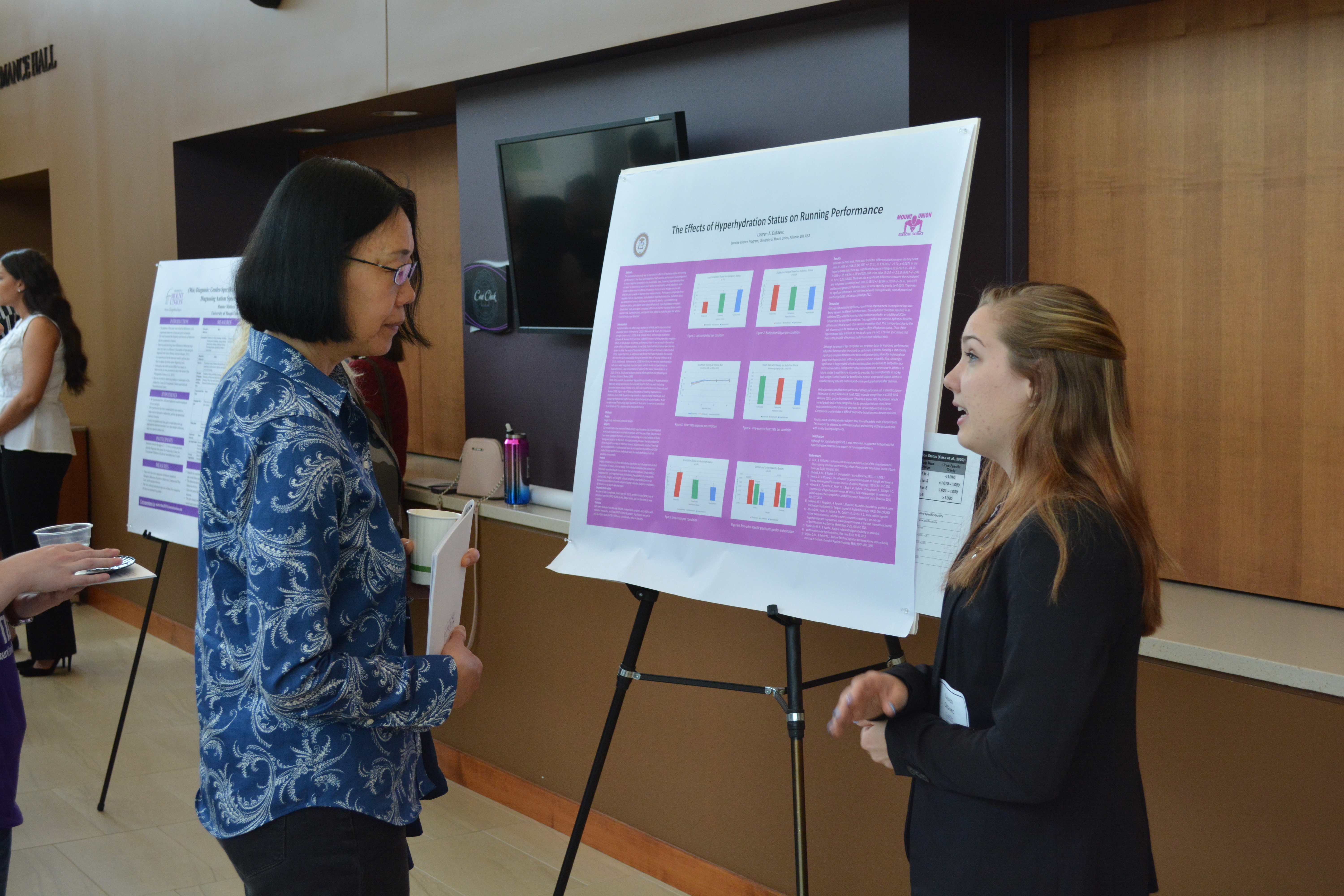
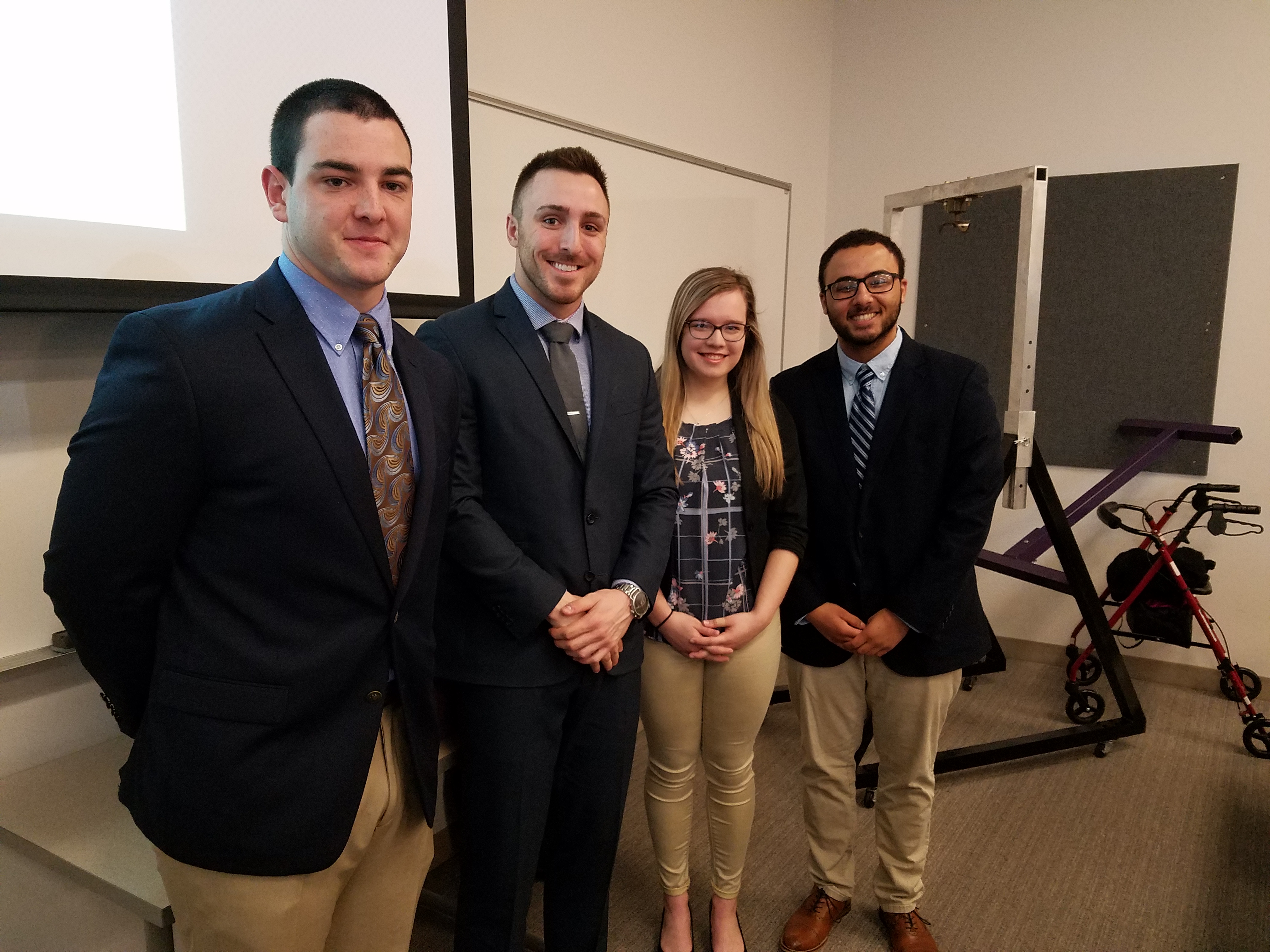
“Gait Test Assistive Device”
Dr. Joshua Gargac
Kathleen Allen – Mechanical Engineering – Gallipolis, OH
Zachary Dozier – Mechanical Engineering – Dover, OH
Gunnar Maher – Mechanical Engineering – Bradford, OH
Thomas Petrella – Mechanical Engineering – Avon Lake, OH
The presentation highlighted the research and construction of GAIT-X, which is a device for individuals to use during gait tests that will allow them to walk without stability products like canes and walkers, which can alter the results of a gait test. The product created allows a physically unstable patient to maintain natural arm motion and stride length during the test. The goal of the device is to not alter the patient’s gait velocity or stride length. The group built the device from a $1000 grant/award from the Mount Union Engineering Department.
“We were approached by the exercise science department and we had conversations with Dr. Saunders about the design requirements for the gait test assistive device. From those requirements, we were able to design and manufacture our final product, which is the Gait-X.” Allen said.
When asked about using this for hip or joint rehabilitation as well. “We did some market research for this and submitted an abstract to a conference. We saw different areas where this could be used possibly in hip rehabilitation or bigger facilities that are doing different kinds of testing, also like balance testing. There’s a lot of different areas that you can use this,” said Dozier.
“Effects of Caffeinated Chewing Gum in Collegiate Soccer Players: Improving a Battery of Common Soccer Tests”
Dr. Ronald Mendel
Dillon Frees – Exercise Science – Loveland, OH
Barry Myers – Exercise Science – Fairview Park, OH
Barry Myers and Dillon Frees, seniors majoring in exercise science, presented their research about the effects of caffeinated chewing gum in collegiate soccer players. Myers and Frees cited academic research showing that caffeine improves endurance, performance, muscular strength, power and reactive agility. Additionally, they found that non-traditional methods of caffeine consumption, such as caffeinated chewing gum, are on the rise because they allow for speedier caffeine absorption. This could benefit athletes where there is limited time for nutrition interventions in competitions or games, or during a halftime. The purpose of the study was to determine the ergogenic and physiological effects that caffeinated chewing gum will have on a battery of common soccer tests in collegiate soccer athletes.
Myers and Frees’ study utilized a double-blind experimental design and was conducted in two phases. The research participants were 16 division three soccer players, eight women and eight men. There was a caffeine versus placebo group. During phase one a randomized sub-set of eight subjects who chewed the caffeinated chewing gum for five minutes had blood drawn at the baseline, ten- and twenty-minute mark to be analyzed for caffeine absorption. In phase II, subjects were randomly given either placebo or caffeinated gum and performed a series of common soccer tests which included: standing broad jump, counter movement jump, arrowhead agility test, 30m sprint and a timed one-mile run. Following a seven-day washout period the same protocol was repeated but with the other intervention.
The results of the study showed that while the caffeine was significantly absorbed by the participants in the caffeine group, there was not a statistically significant difference between the performance of the caffeine versus the placebo group except in the one mile run—each participant in the caffeine group decreased their mile time by an average of 11 seconds. In further tests Myers & Frees would use a longer onset time for caffeine absorption, analyze gender differences, compare different sources of caffeine, and look at soccer tests that include the ball.
“’It’s the Economy, Stupid’: The Impact of Economic Conditions in the Rust Belt on the 2016 Presidential Election.”
Dr. Lori Kumler
Aaron Merriman — Political Science — Alliance, Ohio
The 2016 Presidential Election was undoubtedly polarizing, and Merriman sought to determine if there was an economic impact as to why some traditionally Democratically aligned counties in the “Rust Belt” of the Midwest decided to vote Republican. The title stemmed from a phrase coined by James Carville during Bill Clinton’s 1992 campaign.
In using 2010 Census data and looking at counties with populations of more than 200,000 people and those that featured the highest percentage of Trump and Clinton voters, Merriman created a linear regression model to analyze the data.
The results found that voter registration and party identification were stronger factors in the voting outcome than the economy. Thus, Merriman believes that Democratic candidates in the 2020 election should soften their views in order to find success in the Rust Belt.